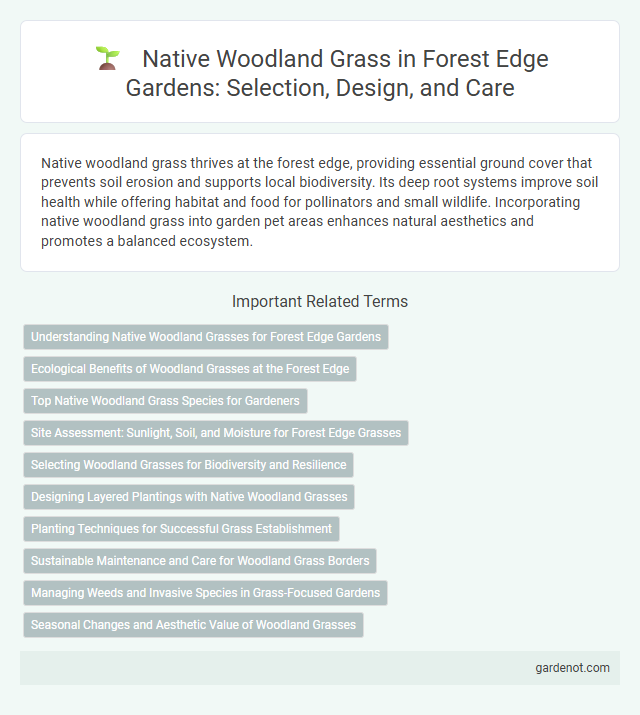Native woodland grass thrives at the forest edge, providing essential ground cover that prevents soil erosion and supports local biodiversity. Its deep root systems improve soil health while offering habitat and food for pollinators and small wildlife. Incorporating native woodland grass into garden pet areas enhances natural aesthetics and promotes a balanced ecosystem.
Understanding Native Woodland Grasses for Forest Edge Gardens
Native woodland grasses such as *Brachypodium sylvaticum* and *Molinia caerulea* thrive in shaded, moist environments typical of forest edge gardens, providing essential ground cover that prevents soil erosion and supports local biodiversity. These grasses exhibit adaptive root systems that improve soil structure and water retention while creating habitat for pollinators and small wildlife. Selecting native species enhances ecosystem resilience and maintains the natural balance essential for sustainable forest edge garden design.
Ecological Benefits of Woodland Grasses at the Forest Edge
Native woodland grasses at the forest edge play a crucial role in stabilizing soil and preventing erosion, which helps maintain ecosystem integrity. These grasses provide essential habitat and food sources for diverse wildlife, including pollinators and ground-nesting birds. Their deep root systems enhance nutrient cycling and support forest regeneration by improving soil structure and moisture retention.
Top Native Woodland Grass Species for Gardeners
Top native woodland grass species ideal for forest edge gardens include Carex pensylvanica (Pennsylvania sedge), which thrives in shaded, well-drained soils and provides attractive groundcover. Deschampsia flexuosa (wavy hair grass) adds texture with its fine, arching blades and tolerates acidic forest soils. These species enhance biodiversity, support native wildlife, and require minimal maintenance, making them perfect for naturalistic garden designs.
Site Assessment: Sunlight, Soil, and Moisture for Forest Edge Grasses
Forest edge native woodland grasses thrive in dappled sunlight with partial shade, reflecting their adaptation to filtered light conditions found at forest margins. Soil composition at these sites is typically well-drained, slightly acidic to neutral, and rich in organic matter, supporting robust root development and nutrient uptake. Moisture levels should be consistently moderate, avoiding waterlogged or excessively dry conditions to maintain optimal growth and ecological balance.
Selecting Woodland Grasses for Biodiversity and Resilience
Selecting native woodland grasses enhances forest edge gardens by promoting biodiversity and ecosystem resilience. Species such as wood fescue (Festuca altissima) and woodland bluegrass (Poa nemoralis) provide essential habitat and food sources for native wildlife while supporting soil health through their deep root systems. Incorporating these grasses helps stabilize the garden's microclimate, improving resistance to invasive species and environmental stressors.
Designing Layered Plantings with Native Woodland Grasses
In a forest edge garden, incorporating native woodland grasses such as Poa nemoralis and Deschampsia cespitosa creates dynamic textural contrasts and enhances biodiversity. These grasses thrive in shaded understory conditions, providing seasonal interest with their graceful blades and seed heads that support local wildlife. Designing layered plantings with native woodland grasses establishes a naturalistic habitat, promoting soil stability and complementing adjacent shrubs and wildflowers for a balanced ecosystem.
Planting Techniques for Successful Grass Establishment
Planting native woodland grass at the forest edge requires careful site preparation, including clearing competing vegetation and ensuring soil moisture retention for optimal root development. Use seed broadcasting combined with light raking to enhance seed-to-soil contact, promoting successful germination in shaded or semi-shaded conditions. Regular mulching with leaf litter mimics natural forest floor conditions, improving soil fertility and protecting seedlings during establishment.
Sustainable Maintenance and Care for Woodland Grass Borders
Native woodland grass borders thrive with sustainable maintenance practices that prioritize minimal soil disturbance and organic mulching to enhance soil health. Regular mowing at higher cuts supports grass regeneration and discourages invasive species while preserving native biodiversity. Adequate watering during dry periods and seasonal removal of dead foliage help maintain vigorous growth and ecological balance in forest edge gardens.
Managing Weeds and Invasive Species in Grass-Focused Gardens
Effective management of weeds and invasive species in native woodland grass gardens involves regular monitoring and early removal to prevent competition with native grasses such as Little Bluestem and Pennsylvania Sedge. Implementing selective mowing and targeted herbicide application supports the health of native species while minimizing disturbance to the ecosystem. Promoting dense growth through proper soil preparation and mulching further suppresses invasive plants, ensuring the stability of the woodland edge habitat.
Seasonal Changes and Aesthetic Value of Woodland Grasses
Native woodland grasses undergo vibrant seasonal changes, shifting from fresh green hues in spring and summer to warm golden and copper tones in autumn. These grasses enhance the forest edge garden's aesthetic value by adding texture and movement, creating a dynamic visual contrast with surrounding trees and shrubs. Their natural growth patterns support biodiversity and contribute to a serene, ever-changing landscape throughout the year.
Native woodland grass Infographic

 gardenot.com
gardenot.com